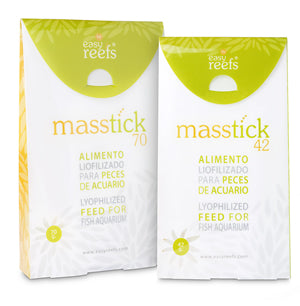Description
Easy Reefs Masstick
Masstick is a blend of diverse, all natural, self-production, highly technical compounds, providing natural and balanced nutrition for omnivorous fish and marine invertebrates.
Masstick is comprised of raw materials of marine origin. It does not contain attractants, artificial preservatives or synthesis products.
Masstick is a self-adhesive paste in a powder formula, ready for rehydration with water.
Once it is rehydrated, it can be stuck to any surface of the aquarium, depending on the animals’ needs.
The rehydratable powder formula allows Masstick to be blended with any mollusc or crustacean pulp as well as eggs from fish, molluscs and crustaceans, artemia, mysids, copepods, rotifers and medicines that are administered orally.
Once prepared and introduced into the aquarium, Masstick does not disperse into the water for hours, so it can be completely taken advantage of by fish and crustaceans. This feature allows the product to be used as “ad libitum” or rationed feeding.
Because Masstick is comprised mainly of freeze-dried crustaceans, it does not contain fish skeletons and is thus very low in phosphates compared to its protein content.
Instructions
Add Masstick to osmosis water in a 1 to 0.5 ratio.
Example: Mix 14 g. of Masstick with 7 ml. of osmosis water. Knead in a small ziplock bag until a homogenous mixture is obtained.
Once the mixture is homogenous, Masstick may be used immediately or frozen for later use. If freezing Masstick, it should be used within five weeks after preparation.
Instructions for use:
Take a portion of Masstick and stick it on a rock, a branched coral skeleton, or the aquarium glass (preferably on the lower third), or depending on the food-obtaining habits of the animals in the aquarium.


